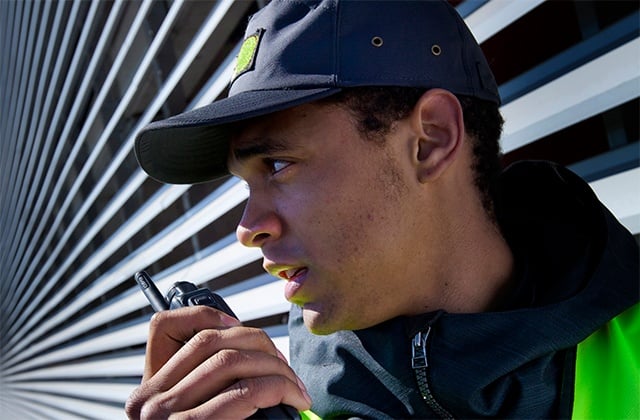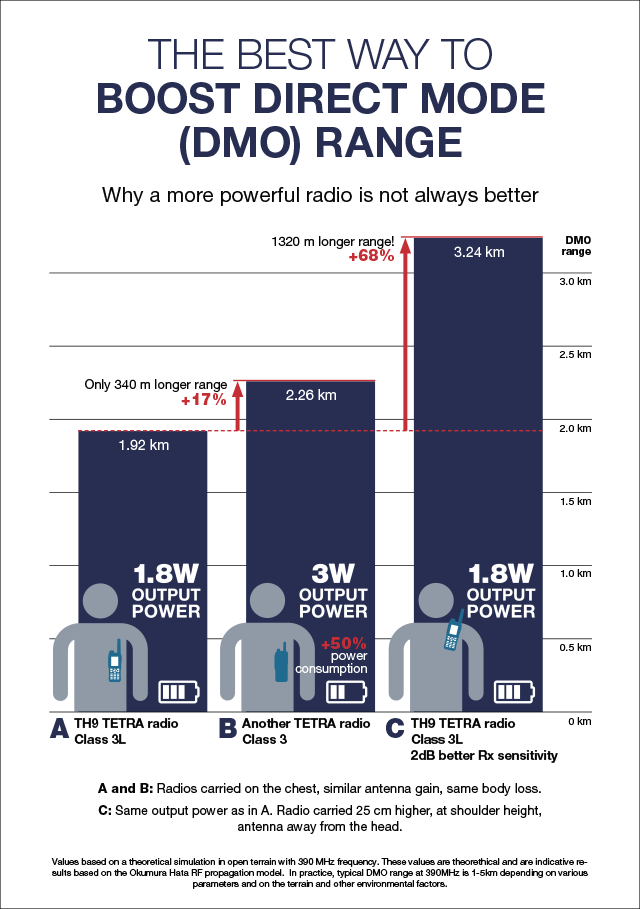It seems obvious, doesn’t it? The more output power a TETRA radio has, the further it will reach in Direct Mode? But not so, think again.
In fact, more power will not give you a much better TETRA radio range in Direct Mode (DMO). Read on to learn why – and to discover the best way to achieve the best Direct Mode range.
Let’s first consider two handheld TETRA radios. The first transmits at 1.8 Watts output power, which will yield a DMO range of around 1.92 km. Now let’s look at a second radio which transmits at 3 Watts. How much further will the second radio typically reach in DMO?
It may seem logical, but it is also wrong to think that almost double the transmission power would also give you almost double the range. In fact, the calculated reach* is only 340 meters longer, a measly 17% boost.
What’s more, the power going into the transmission will drain the radio battery. The 3 Watt transmission power will consume a whopping 50% more current!
Your next thought may be, “Well, the higher power will not boost the DMO range all that much, but it’s the only way to get it”. Good news – you would be wrong again!
Higher power is not the only way to get it. And it is definitely not the best way to boost your DMO range.

Your top ways to boost DMO range
1 - Reduce body loss
Body loss occurs when the radio signals are blocked by the radio user’s own body, and is a significant factor to consider. Carrying the radio low, and especially having the radio antenna at a low position, will dramatically increase body loss.
Instead, carry the radio near your shoulder, with its antenna extending above the shoulder line.
2 - Choose more sensitive radios
Even in Direct Mode, radio communication needs to be two-way – after all, why should one party talk and get no response? This means that the ability of radios to pick up the signals – their sensitivity – is an important factor.
A more sensitive receiver in the radios means in practice that they can transmit at lower power and still have a longer DMO range. This is the way to go because battery consumption will stay the same. A big advantage for users!
The best option
The best option, of course, is to combine options 1 and 2.
Let’s now take a third radio - for example, the TH9 handheld TETRA radio with a very sensitive -109 dBm receiver. When this radio is carried on top of the shoulder, with the antenna away from the head, DMO coverage will increase to 3.24 kilometers.
That’s a 68% better range with zero percent extra drain on the radio battery.
That’s a pretty sweet deal, isn’t it?
Check the details from an infographic which describes the best way to boost DMO coverage – and why a more powerful TETRA radio is not always better. You can also download the same infographic in printable format.

Download the infographic as pdf for printing in A4 size:
* These values are based on a theoretical simulation in open terrain with 390 MHz frequency. These values are theorethical and are indicative results based on the Okumura Hata RF propagation model. In practice, typical DMO range at 390MHz is 1-5km depending on various parameters and on the terrain and other environmental factors.
=====
You may also be interested in these earlier blog post:
Post which explains why a more powerful PMR radio does not enjoy better coverage in network mode: Do you know the secret about Watts in your PMR radio? (Nobody else will tell you)
Post which deciphers the IP classification ratings of PMR radios: Do you have this wrong idea about IP protection ratings?





